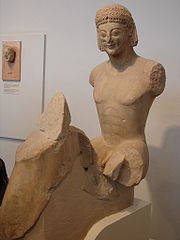
Rampin Rider
Encyclopedia

Ancient Greece
Ancient Greece is a civilization belonging to a period of Greek history that lasted from the Archaic period of the 8th to 6th centuries BC to the end of antiquity. Immediately following this period was the beginning of the Early Middle Ages and the Byzantine era. Included in Ancient Greece is the...
. The statue was made of marble and has traces of red and black paint. The head of the rider was found on the Acropolis of Athens
Acropolis of Athens
The Acropolis of Athens or Citadel of Athens is the best known acropolis in the world. Although there are many other acropoleis in Greece, the significance of the Acropolis of Athens is such that it is commonly known as The Acropolis without qualification...
in 1877 and donated to the Louvre
Louvre
The Musée du Louvre – in English, the Louvre Museum or simply the Louvre – is one of the world's largest museums, the most visited art museum in the world and a historic monument. A central landmark of Paris, it is located on the Right Bank of the Seine in the 1st arrondissement...
. Parts of the body of the rider and horse were found ten years earlier in a ditch filled with statues broken during the 480 BC Persian sack of Athens. The head was not associated with the rest of the statue until 1936. The statue is displayed with a plaster cast of the head at the Acropolis Museum
Acropolis Museum
The Old Acropolis Museum was an archaeological museum located in Athens, Greece on the archeological site of Acropolis. It is built in a niche at the eastern edge of the rock and most of it lies beneath the level of the hilltop, making it largely invisible. It was considered one of the major...
while the head remains at the Louvre and is displayed with a cast of the rest statue.
The rider has many of the features typical of an Archaic kouros
Kouros
A kouros is the modern term given to those representations of male youths which first appear in the Archaic period in Greece. The term kouros, meaning youth, was first proposed for what were previously thought to be depictions of Apollo by V. I...
, but has several asymmetrical features that break with the period's conventions.
Interpretations
The statue was originally thought to be a part of a set statues, perhaps paired with another as a mounted presentation of Castor and PolluxCastor and Pollux
In Greek and Roman mythology, Castor and Pollux or Polydeuces were twin brothers, together known as the Dioscuri . Their mother was Leda, but Castor was the mortal son of Tyndareus, king of Sparta, and Pollux the divine son of Zeus, who visited Leda in the guise of a swan...
common on vases from this period. According to another theory, the statue represents the winner of a race. This theory is supported by the crown of lovage
Lovage
Lovage is a tall perennial plant, the sole species in the genus Levisticum, in the family Apiaceae, subfamily Apioideae, tribe Apieae.-Distribution:...
, given to winners of the Nemean Games
Nemean Games
The Nemean Games were one of the four Panhellenic Games of Ancient Greece, and were held at Nemea every two years ....
and the Isthmian Games
Isthmian Games
The Isthmian Games or Isthmia were one of the Panhellenic Games of Ancient Greece, and were named after the isthmus of Corinth, where they were held...
, on the statue.

